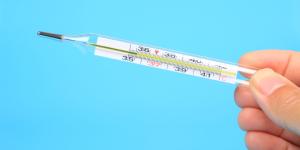Is a temperature of 104 dangerous?


Our body temperature allows us to evaluate the efficiency of the thermal regulation that occurs in the human body through changes in the temperature of the environment and the intensity of activity. The peripheral temperature (skin, mucous membranes, muscles, limbs, etc.) can vary. The normal body temperature of a person varies depending on gender, recent activity, consumption of food and fluids, the time of day and, in women, the menstrual cycle phase they're on. In this article from OneHowTo.com we want to explain whether a body temperature of 104 degrees farenheit is dangerous (40- 40.1 -40.2 celcius).
Is a temperature of 104 dangerous for adults?
It is considered a fever when the patient has an axillary temperature above 38 degrees Celsius or 100.4 degrees farenheit, so a body temperature of 104 farenheit means a very high fever. Fevers should be seen as a defence mechanism of the body, responsible for warning us that something is happening so we can get in touch with our doctor. The normal body temperature of a human adult varies between 36.5-37.5° C or 97.7° F - 99.5° F or more. The general rules are:
- Hypothermia, when the temperature is less than 36°C/95.8° F.
- Fever, when the temperature is between 37.1° to 37.9° C/98.7° to 100.2° F ·
- Hyperthermia or fever, when the temperature is equal or above 38° C/100.4° F.
Is a body temperature of 104 dangerous for a child?
A body temperature of 40° C or 104° F in children is very high so take action and get in touch with your doctor. Children should have a maximum temperature of 37.5 up to 3 years old, and up to 37 until 6 years old.

Axillary temperature
It is considered a fever when the patient has an axillary temperature above 38 degrees Celsius or 100.4 degrees Farenheit, so having a body temperature from 40° C/ 104° F means a high fever.
Oral temperature
It's considered a fever if the patient has an oral temperature greater than 38 degrees Celsius or 100.4 degrees Farenheit, therefore a body temperature from 40°C/104° F means a high fever.
Oral temperature should be measured in all patients, except when they are unconscious, have mental confusion, seizures, nasal, mouth or throat disorders, and if they are children under 6 years old.
Rectal temperature
It's considered a fever if the patient has a rectal temperature over 38.5 degrees Celsius, so a body temperature from 40° C/104° F means a high fever.
The result tends to be 0.5 to 0.7 degrees greater than the oral temperature. Taking the rectal temperature is recommended for patients under 6 years old, especially babies.
Influences on body temperature
There are several factors that affect body temperature that can change temperature by a few decimals, but having a body temperature below 35 degrees Celcius or 95 Farenheit is cause for concern. The physique of the individual, especially if they are obese. Age, being worse for the elderly and the sickly. Other external factors that may make someone hot :
- Adaptation, which is known as acclimatisation.
- The degree of atmospheric humidity: More humidity increases the difficulty of absorbing the sweat produced.
- Clothing: dark and thick clothing is more harmful.
- Having diseases that hinder sweating: diabetes and heart, lung and kidney impairment. Diseases associated with increased heat production: infections, hyperthyroidism and those that accompany fever.
- Consumption of certain sedatives, amphetamines and antidepressants.
- Psychopathy and states of acute alcoholism or that decrease chronic tolerance to heat.
This article is merely informative, oneHOWTO does not have the authority to prescribe any medical treatments or create a diagnosis. We invite you to visit your doctor if you have any type of condition or pain.
If you want to read similar articles to Is a temperature of 104 dangerous?, we recommend you visit our Diseases & secondary effects category.
Tips
- Axillary temperature should be taken with a thermometer in the above recommended area for a period of approximately 4 (four) minutes.






